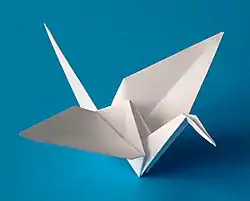鶴
| ||||||||
 | ||||||||
| ||||||||
Translingual
Han character
鶴 (Kangxi radical 196, 鳥+10, 21 strokes, cangjie input 十土竹日火 (JGHAF) or 人土竹日火 (OGHAF), four-corner 47227, composition ⿰隺鳥)
Derived characters
References
- Kangxi Dictionary: page 1496, character 20
- Dai Kanwa Jiten: character 47185
- Dae Jaweon: page 2026, character 10
- Hanyu Da Zidian (first edition): volume 7, page 4654, character 3
- Unihan data for U+9DB4
- Unihan data for U+FA2D
Chinese
| trad. | 鶴 | |
|---|---|---|
| simp. | 鹤 | |
| alternative forms | 鸖 䳽/𮹙 隺 | |
Glyph origin
Phono-semantic compound (形聲/形声, OC *ɡloːwɢ) : phonetic 寉 (OC *ɡluːwɢ) + semantic 鳥.
Etymology
Possibly from Austroasiatic (Schuessler, 2007). Compare Proto-Mon-Khmer *kl(uə)k (“white”), whence Proto-Vietic *t-lɔːk (“white”) but Old Mon kloh (“crane”).
Pronunciation
Compounds
- 一琴一鶴/一琴一鹤
- 不舞之鶴/不舞之鹤
- 丹頂鶴/丹顶鹤 (dāndǐnghè)
- 乘軒鶴/乘轩鹤
- 乘鶴/乘鹤
- 乘鶴駕雲/乘鹤驾云
- 仙鶴/仙鹤 (xiānhè)
- 仙鶴草/仙鹤草 (xiānhècǎo)
- 別鶴/别鹤
- 別鶴孤鸞/别鹤孤鸾
- 別鶴操/别鹤操
- 別鶴離鸞/别鹤离鸾
- 化鶴/化鹤
- 吼鶴/吼鹤
- 妻梅子鶴/妻梅子鹤
- 孤雲野鶴/孤云野鹤
- 孤鸞寡鶴/孤鸾寡鹤
- 寡鶴/寡鹤
- 弔鶴/吊鹤
- 彥倫鶴怨/彦伦鹤怨
- 慚鳧企鶴/惭凫企鹤
- 控鶴/控鹤
- 揚州鶴/扬州鹤
- 斷鶴續鳧/断鹤续凫 (duànhèxùfú)
- 朱顏鶴髮/朱颜鹤发
- 杳如黃鶴/杳如黄鹤
- 松鶴/松鹤
- 松鶴延年/松鹤延年
- 枯魚病鶴/枯鱼病鹤
- 梅妻鶴子/梅妻鹤子 (méiqīhèzǐ)
- 梅鶴因緣/梅鹤因缘
- 水鶴/水鹤
- 火鶴花/火鹤花
- 灰鶴/灰鹤
- 焚琴煮鶴/焚琴煮鹤 (fén qín zhǔ hè)
- 煮鶴焚琴/煮鹤焚琴
- 煮鶴燒琴/煮鹤烧琴
- 猿鶴沙蟲/猿鹤沙虫
- 猿鶴蟲沙/猿鹤虫沙
- 玄鶴/玄鹤
- 王喬騎鶴/王乔骑鹤
- 瘞鶴銘/瘗鹤铭
- 白頂鶴/白顶鹤
- 白鶴/白鹤 (báihè)
- 白鶴秀才/白鹤秀才
- 童顏鶴髮/童颜鹤发 (tóngyánhèfà)
- 紅鶴/红鹤 (hónghè)
- 羊公鶴/羊公鹤
- 群雞一鶴/群鸡一鹤
- 老鶴乘軒/老鹤乘轩
- 華亭鶴唳/华亭鹤唳
- 華表鶴歸/华表鹤归
- 蟲沙猿鶴/虫沙猿鹤
- 跨鶴/跨鹤
- 遼東鶴/辽东鹤
- 野鶴/野鹤
- 野鶴閒雲/野鹤闲云
- 閒雲孤鶴/闲云孤鹤
- 閒雲野鶴/闲云野鹤
- 雞皮鶴髮/鸡皮鹤发 (jīpíhèfà)
- 雞膚鶴髮/鸡肤鹤发
- 雲中白鶴/云中白鹤
- 青鶴/青鹤
- 風聲鶴唳/风声鹤唳 (fēngshēnghèlì)
- 風鶴/风鹤
- 風鶴魂驚/风鹤魂惊
- 駕鶴西歸/驾鹤西归
- 騎鶴揚州/骑鹤扬州
- 鶴乘軒/鹤乘轩
- 鶴企/鹤企
- 鶴俸/鹤俸
- 鶴列/鹤列
- 鶴唳/鹤唳
- 鶴唳風聲/鹤唳风声
- 鶴壁/鹤壁 (Hèbì)
- 鶴壽/鹤寿
- 鶴宮/鹤宫
- 鶴岡/鹤冈 (Hègāng)
- 鶴峰/鹤峰 (Hèfēng)
- 鶴弔/鹤吊
- 鶴形目/鹤形目
- 鶴書/鹤书
- 鶴望/鹤望
- 鶴林/鹤林
- 鶴板/鹤板
- 鶴林玉露/鹤林玉露
- 鶴步/鹤步
- 鶴氅/鹤氅
- 鶴神/鹤神
- 鶴禁/鹤禁
- 鶴科/鹤科
- 鶴立/鹤立
- 鶴立雞群/鹤立鸡群 (hèlìjīqún)
- 鶴算龜齡/鹤算龟龄
- 鶴膝/鹤膝
- 鶴膝風/鹤膝风
- 鶴舞/鹤舞
- 鶴處雞群/鹤处鸡群
- 鶴觴/鹤觞
- 鶴警/鹤警
- 鶴長鳧短/鹤长凫短 (hèchángfúduǎn)
- 鶴頂紅/鹤顶红
- 鶴馭/鹤驭
- 鶴駕/鹤驾
- 鶴骨松姿/鹤骨松姿
- 鶴髮/鹤发 (hèfà)
- 鶴髮童顏/鹤发童颜 (hèfàtóngyán)
- 鶴髮雞皮/鹤发鸡皮
- 鶴鳴/鹤鸣
- 鶴鳴之士/鹤鸣之士
- 鶴鳴九皋/鹤鸣九皋
- 鶴鶴/鹤鹤
- 鶴齡/鹤龄
- 鸞鶴/鸾鹤 (luánhè)
- 黃鶴樓/黄鹤楼 (Huánghèlóu)
- 龜年鶴壽/龟年鹤寿
- 龜鶴/龟鹤
- 龜鶴同春/龟鹤同春
- 龜齡鶴算/龟龄鹤算
Japanese
Readings
Etymology 1

| Kanji in this term |
|---|
| 鶴 |
| つる Grade: S |
| kun’yomi |
Given a crane's long neck and how the bird hunts, possibly related to 蔓 (tsuru, “vine”); 弦 (tsuru, “bowstring; musical instrument string”); 釣る, 吊る (tsuru, “to hang down; to string up; to fish”). Given how cranes flock together, possibly related also to 連る (tsuru), older root form of modern verb 連れる (tsureru, “to accompany”). That said, 連る also appears to ultimately derive from 蔓 (tsuru, “vine”).
Vovin (2008) considers it possibly related to an ancestor of Korean 두루미 (durumi, “crane”), with a root-final -m vanishing later, leaving only a Kansai accent pattern behind.[1] May ultimately be a regional Wanderwort. Compare also Proto-Finno-Ugric *tërka (“crane”), and Proto-Turkic *turunya (“crane”) (whence Turkish turna), Mongolian тогоруу (togoruu, “crane”). (Can this(+) etymology be sourced?)
The reading tsuru is first seen used to mean “a crane” from the late Heian period. Prior to that time, the only reading used for the bird was tazu. However, the kanji 鶴 was used in the Man'yōshū (759 CE) as a 借訓 (shakkun) reading for つる (turu → tsuru), the 連体形 (rentaikei, “attributive form”) of つ (tu → tsu, auxiliary verb of affirmation, certainty, or completion), suggesting that tsuru may have already existed as an everyday term meaning “a crane”.[2]
Noun
鶴 or 鶴 • (tsuru)
- a crane (large, long-legged and long-necked bird of the family Gruidae)
- Short for 折鶴 (orizuru): a paper crane, the archetypical origami design
- Short for 鶴嘴 (tsuruhashi): a pickaxe
- a 家紋 (kamon, “family crest”) depicting a crane
- (euphemistic) white hair
- Synonym: 白髪 (shiraga)
- a decoration made of straws and reeds in the form of two cranes, used during the 14th year of the first month in the former town of Sakurajima, Kagoshima Prefecture
Usage notes
- As with many terms that name organisms, this term is often spelled in katakana, especially in biological contexts (where katakana is customary), as ツル.
Derived terms
- 鶴岡 (Tsuruoka)
- 鶴ヶ城 (Tsurugajō)
- 鶴亀 (tsurukame)
- 鶴首, 鶴頸 (tsurukubi)
- 鶴三 (Tsuruzō)
- 鶴の戒め (tsuru no imashime)
- 鶴の毛衣 (tsuru no kegoromo)
- 鶴の子 (tsurunoko)
- 鶴の孫 (tsuru no mago)
- 鶴の丸 (tsuru no maru)
- 鶴脛 (tsuruhagi)
- 鶴嘴 (tsuruhashi)
- 鶴斑 (tsurubuchi)
- 鶴擬 (tsurumodoki)
- 鶴屋 (Tsuruya)
- 姉羽鶴 (anehazuru)
- 折鶴 (orizuru)
- 鸛鶴 (kōzuru)
- 白鶴 (shiratsuru)
- 千羽鶴 (senbazuru)
- 黒鶴 (kurozuru)
- 丹頂鶴 (tanchōzuru)
- 友鶴 (tomozuru)
- 鍋鶴 (nabezuru)
- 引き鶴 (hikizuru)
- 紅鶴 (benizuru)
- 真鶴, 真名鶴 (manazuru)
- 万羽鶴 (manbazuru)
- 夕鶴 (yūzuru)
- 夜の鶴 (yoru no tsuru)
Idioms
- 鶴来る (tsuru kitaru)
- 鶴の一声 (tsuru no hitokoe)
- 凍て鶴 (itezuru, “frozen crane → a metaphor for something stock still and unmoving, from the way a crane will freeze when hunting”)
- 子を思う鶴 (ko o omō tsuru)
- 塵塚に鶴 (chirizuka ni tsuru)
- 掃き溜めに鶴 (hakidame ni tsuru)
Proverbs
- 鶴九皐に鳴き声天に聞こゆ (tsuru kyūkō ni naki koe ten ni kikoyu)
- 鶴は千年亀は万年 (tsuru wa sennen kame wa mannen)
Etymology 2
| Kanji in this term |
|---|
| 鶴 |
| たず Grade: S |
| kun’yomi |
| Alternative spelling |
|---|
| 田鶴 |
/tadu/ → /tad͡zu/ → /tazu/
From Old Japanese.[2][3]
Speculatively, this could be analyzed as a compound of た (ta, possibly 田 (“rice paddy”), where cranes are known to hunt) + つ (*tsu, uncertain, possibly “a large bird”), wherein the tsu changes to dzu, modern zu, as an instance of rendaku (連濁). This tsu may be the tsu in modern tsuru above. (Can this(+) etymology be sourced?)
Noun
Derived terms
Derived terms
Idioms
References
- Bjarke Frellesvig and John Whitman, editors (2008), chapter 7, in Proto-Japanese: Issues and Prospects, Amsterdam, Philadelphia: John Benjamins Publishing Company, Proto-Japanese beyond the accent system, pages 140-156
- Shōgaku Tosho (1988) 国語大辞典(新装版) [Unabridged Dictionary of Japanese (Revised Edition)] (in Japanese), Tōkyō: Shogakukan, →ISBN
- Matsumura, Akira, editor (2006), 大辞林 [Daijirin] (in Japanese), Third edition, Tōkyō: Sanseidō, →ISBN
- NHK Broadcasting Culture Research Institute, editor (1998), NHK日本語発音アクセント辞典 [NHK Japanese Pronunciation Accent Dictionary] (in Japanese), Tōkyō: NHK Publishing, →ISBN
Korean
Etymology
From Middle Chinese 鶴 (MC hak).
| Historical Readings | ||
|---|---|---|
| Dongguk Jeongun Reading | ||
| Dongguk Jeongun, 1448 | ᅘᅡᆨ〮 (Yale: hhák) | |
| Middle Korean | ||
| Text | Eumhun | |
| Gloss (hun) | Reading | |
| Hunmong Jahoe, 1527 | 학〮 (Yale: hák) | 학〮 (Yale: hák) |
Pronunciation
- (SK Standard/Seoul) IPA(key): [ha̠k̚]
- Phonetic hangul: [학]
Compounds
Okinawan
References
- “チル” in Okinawa Center of Language Study, Shuri-Naha Dialect Dictionary (archived; reopens 2024).(permanent dead link)
Old Japanese
Etymology 1
Possibly a compound of 田 (ta, “rice paddy”, where cranes are known to hunt) + つ (*tu, uncertain, possibly “a large bird”). (Can this(+) etymology be sourced?)
Noun
鶴 (tadu) (kana たづ)
- a crane (large, long-legged and long-necked bird of the family Gruidae)
- 711–712, Kojiki, lower volume (Emperor Ingyō; poem 85):
- 阿麻登夫登理母都加比曾多豆賀泥能岐許延牟登岐波和賀那斗波佐泥
- ama-to2bu to2ri mo2 tukapi1 so2 tadu ga ne no2 ki1ko2yemu to2ki1 pa waga na to1pasane
- (please add an English translation of this quotation)
-
- 藻苅舟奧榜來良之妹之嶋形見之浦爾鶴翔所見
- mokari-bune oki1 ko2gi1kurasi Imogasima Katami1-no2-ura ni tadu kake2ru mi1yu
- Rowing the seaweed-gathering boat out to sea and back again, I saw the cranes soaring by Katami inlet on Imogashima.
- For more quotations using this term, see Citations:鶴.
Quotations
For quotations using this term, see Citations:鶴.
Derived terms
- 鶴が音 (tadu ga ne)
- 鶴群 (tadumura)
- 蘆鶴 (asitadu)
Descendants
- Japanese: 鶴 (tazu)
Etymology 2
The 借訓 (shakkun) reading of modern Japanese 鶴 (tsuru, “crane”).
In turn, from Proto-Japonic *turum (“crane”).
Phonogram
鶴 (turu)
- Denotes phonographic disyllable つる (turu)
-
- ...相見鶴鴨
- ...api1mituru ka mo
- ...[as] they looked [at each other]!
-
Descendants
- Japanese: 鶴 (tsuru, “crane”)
Further reading
- Vovin (2020) p. 34

